Occidentalia is a monotypic moth genus of the family Crambidae described by Harrison Gray Dyar Jr. and Carl Heinrich in 1927. It contains only one species, Occidentalia comptulatalis, described by George Duryea Hulst in 1886. It is found in North America, where it has been recorded from Alberta, Indiana, Maine, Manitoba, Minnesota, New York, Ontario, Quebec and Saskatchewan.
Xanthophysa is a monotypic moth genus of the family Crambidae described by Eugene G. Munroe in 1964. It contains only one species, Xanthophysa psychialis, the xanthophysa moth, described by George Duryea Hulst in 1886. It is found in North America, where it has been recorded from Alabama, Florida, Illinois, Indiana, Kentucky, Maine, Mississippi, New Hampshire, New Jersey, North Carolina, Ohio, Ontario, Quebec, South Carolina and Tennessee.

Loxostege is a genus of moths of the family Crambidae.

Catocala blandula, the charming underwing, is a moth of the family Erebidae. The species was first described by George Duryea Hulst in 1884. It is found in North America from Nova Scotia west to central Alberta, south to Pennsylvania and Wisconsin.
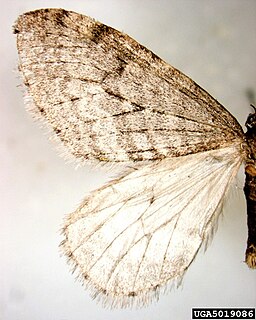
Operophtera bruceata, the Bruce spanworm, hunter's moth, or native winter moth is a moth of the family Geometridae. The species was first described by George Duryea Hulst in 1886. It is found from coast to coast in southern Canada and the northern parts of the United States.
Idia immaculalis, the immaculate idia, is a litter moth of the family Erebidae. The species was first described by George Duryea Hulst in 1886. It is found in North America from at least California, north and east across Montana to southern Alberta and Saskatchewan.

Gesneria centuriella is a species of moth in the family Crambidae described by Michael Denis and Ignaz Schiffermüller in 1775. It is found from Europe, east to Japan. It is also present in Greenland and northern North America.

Loxostege commixtalis, the alfalfa webworm, is a species of moth in the family Crambidae. It was described by Francis Walker in 1866. It is found in Fennoscandia, Estonia and northern Russia. It is also found in North America, where it ranges from Nova Scotia and Newfoundland and Labrador west to the Yukon.
Loxostege ephippialis is a species of moth in the family Crambidae. It was described by Johan Wilhelm Zetterstedt in 1839. It is found in Norway, Sweden, Finland, Russia and North America.

Eupithecia nimbicolor is a moth in the family Geometridae first described by George Duryea Hulst in 1896. It is found in North America from eastern Newfoundland and Labrador to western British Columbia and from Alaska to Arizona.
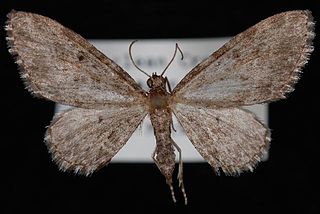
Eupithecia lachrymosa is a moth in the family Geometridae first described by George Duryea Hulst in 1900. It is found in North America from central Saskatchewan west to southern Vancouver Island, north to British Columbia and Alberta and south to California.

Eupithecia niveifascia is a moth in the family Geometridae first described by George Duryea Hulst in 1898. It is found in North America from south-western Alberta west to Vancouver Island, north to northern coastal British Columbia and south to New Mexico.
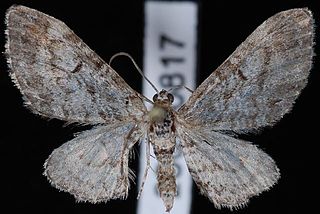
Eupithecia graefi, or Graef's pug, is a moth in the family Geometridae. The species was first described by George Duryea Hulst in 1896. It is found in North America from south-western Alberta west to Vancouver Island, north to Alaska and south to California. The habitat consists of wooded areas.
Crambus trichusalis is a moth in the family Crambidae. It was described by George Duryea Hulst in 1886. It is found in North America, where it has been recorded from Alberta, Saskatchewan, Montana, North Dakota and South Dakota. The habitat consists of grasslands.
Loxostege anartalis is a moth in the family Crambidae. It was described by Augustus Radcliffe Grote in 1878. It is found in North America, where it has been recorded from coast to coast in Canada. In the west, the range extends south to California.
Loxostege offumalis is a moth in the family Crambidae. It was described by George Duryea Hulst in 1886. It is found in North America, where it has been recorded from California.
Loxostege thrallophilalis is a moth in the family Crambidae. It was described by George Duryea Hulst in 1886. It is found in North America, where it has been recorded from southern British Columbia to northern California, as well as from Montana.
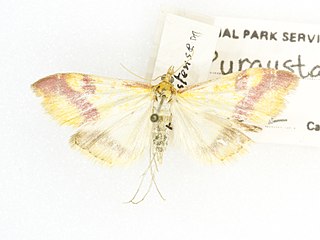
Pyrausta scurralis is a moth in the family Crambidae. It was first observed and described by George Duryea Hulst in 1886. It is found in North America, where it has been recorded/reported in the Canadian provinces of Ontario, Manitoba and Saskatchewan to the US states, California, Arizona, and New Mexico and in Mexico.
Saucrobotys fumoferalis, the dusky saucrobotys moth, is a moth in the family Crambidae. It was described by George Duryea Hulst in 1886. It is found in North America, where it has been recorded from Nova Scotia west to British Columbia, north to Yukon, and south to Pennsylvania, Illinois and California. The habitat consists of boreal forests, mixed forests and woodlots.
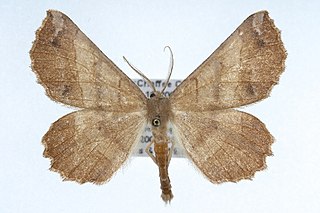
Euchlaena johnsonaria, or Johnson's euchlaena moth, is a moth of the family Geometridae. The species was first described by Asa Fitch in 1870. It is found in North America, where it has been recorded from southern coastal British Columbia east to Nova Scotia, south to New Jersey, Missouri and Oregon. The habitat consists of deciduous wooded areas.











